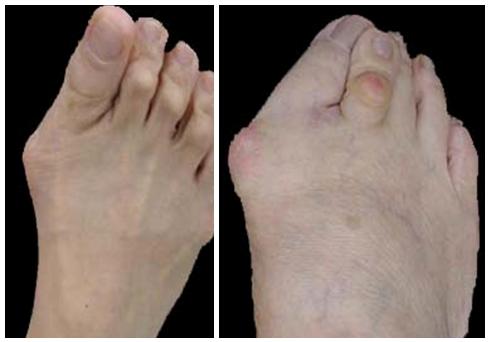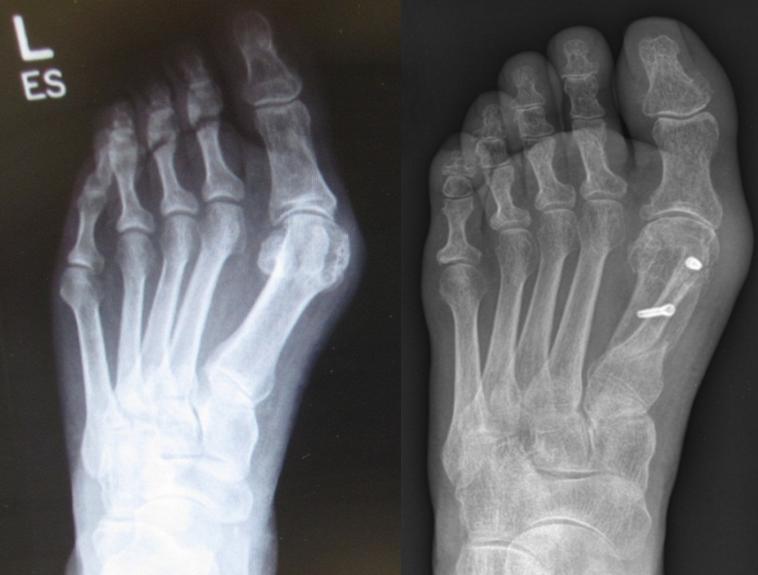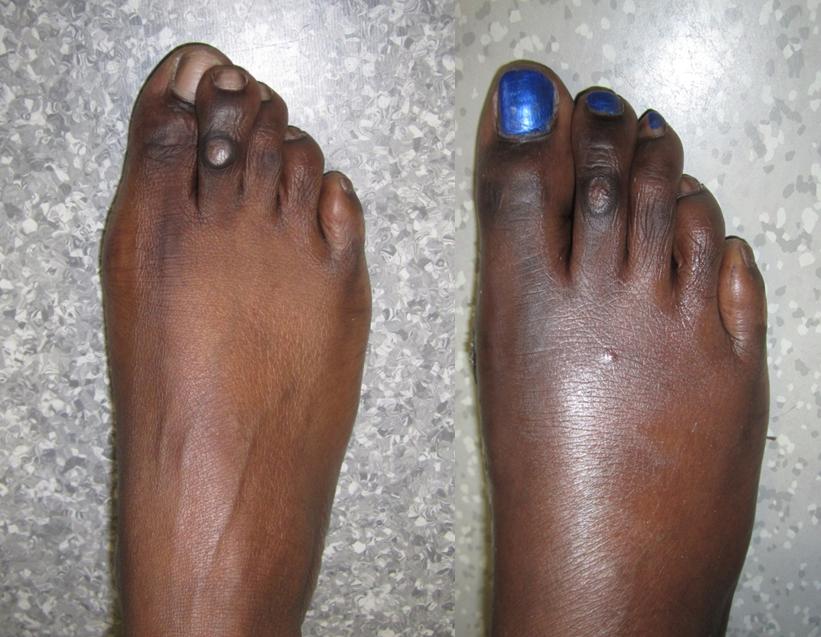This article discusses whether foot deformities qualify for surgery and, if so, whether patients should be given cosmetic foot surgery, or reconstructive Orthopaedic foot surgery.
Contents
- What is cosmetic foot surgery?
- What is the difference between cosmetic and non-cosmetic foot surgery?
- What types of problems can be treated with reconstructive Orthopaedic foot surgery?
- Summary
What is cosmetic foot surgery?
Cosmetic surgery is an established area of medicine, and forms a major part of modern surgical practice. For example, Plastic surgeons commonly perform cosmetic surgery to improve or restore visual appearance, regardless of whether the problem causes pain or dysfunction. This is also known as aesthetic surgery.
It is therefore a natural step, with the cosmetic industry expanding rapidly, for people to enquire about cosmetic surgery for the foot and ankle. This concept has taken off in America, and certain clinics are starting to offer extreme aesthetic foot procedures, which has sparked significant controversy. The President of the British Association of Aesthetic Plastic Surgeons recently sent out warnings, calling for regulation of advertising in the cosmetic industry. Fazel Fatah raised concerns about trivialising major surgery and stated that ‘the pendulum may have swung too far’ and that ‘it is time for change’.
Cosmetic foot surgery implies undertaking surgery to simply improve the visual appearance of the foot. This is controversial, and Orthopaedic surgeons in general do not believe in performing surgery purely for cosmetic reasons. We know that the potential complications associated with Orthopaedic foot surgery are serious and cannot be underestimated. Whilst most people have good results, some will be no better, and others may be worse off. Therefore, pain and dysfunction are important symptoms, and we as Orthopaedic surgeons specifically look for these problems when we first consult with you.
What is the difference between cosmetic and non-cosmetic foot surgery?
The divide between cosmetic and non-cosmetic foot surgery is extremely blurred, as often deformed toes and bunions will be unsightly to look at, but commonly will also rub on shoes, and cause a varying degree of discomfort and pain.
Personally, I never offer surgery to simply improve the visual appearance of the foot; however I am very happy to offer foot surgery for lumps, bumps, toe deformity and bunions that rub on shoes and cause discomfort. Some people still classify this as cosmetic foot surgery, whereas I consider it to be reconstructive Orthopaedic foot surgery performed to improve pain and quality of life.
What types of problems can be treated with reconstructive Orthopaedic foot surgery?
These are many conditions that I treat with reconstructive Orthopaedic foot surgery, which could be classified as cosmetic surgery. These include bunions, deformed and long toes, ganglions and brachymetatarsia (short 4th toe).
Bunions

The medical terminology for bunions is hallux valgus, and describes a deformity of the big toe joint, where the metatarsal drifts inwards and the toe drifts outwards. The end result is a bump which can rub on shoes. Pain and discomfort are common symptoms, not only from the bump, but also from deep within the joint. Whilst the majority of bunions are hereditary (meaning that they run in families), shoe wear and in particular high heeled shoes can accelerate the process of developing a bunion.

If you experience pain and discomfort, surgical correction can be performed, and the success rate is very high. The operation involves cutting the metatarsal bone and shifting it inwards. The metatarsal is fixed with two screws in its new position. In addition the joint is released on the outside and tightened on the inside to balance the big toe and to prevent the deformity coming back (Figs 1a and b). You are allowed to walk immediately with a special heel weight-bearing shoe, however swelling is common and elevation for the first two weeks will make your foot more comfortable and will promote wound healing. The total recovery time for a bunion correction is six to nine months, at which point the swelling and stiffness settles.
If the bunion gives you some pain and discomfort, surgery is not cosmetic, but can be considered to be an Orthopaedic reconstructive procedure. You should seek the help of a Consultant Orthopaedic Foot and Ankle surgeon, like myself, if you would like to discuss correction of your bunion deformity.
Toe deformity including long toes
Deformity of the lesser toes is a common problem and can occur in isolation or in association with big toe joint problems, such as hallux valgus (bunions).

Hammer toe deformity represents the most common problem, and is in fact a very complex problem resulting from muscle and tendon imbalances. The end result is a toe that sits up and rubs on shoes (Fig 2). Surgical correction involves removing the first joint in the toe and stiffening it permanently, we call this a fusion. We also release the tight structures, usually the extensor tendon, which causes the deformity in the first place. A wire is often required to hold the toe straight until healing has occurred after four to five weeks.
Some people have toes of differing length, most commonly a long second toe which rubs in shoes. If the symptoms associated with this deformity are severe, I will offer you a toe shortening procedure.
Removal of lumps and bumps including ganglions
Ganglions are fluid filled lumps which develop around joints and tendons and are common around the foot and ankle. I offer surgical removal, if the lump causes pain and rubs on shoes. The main drawback is that the lump returns in one in three cases.
Other common lumps are exostoses or bony prominences. These usually arise because of underlying ’wear and tear’ or arthritis. If the prominence rubs on shoes and gives pain, simple removal of the bump usually resolves the problem. Sometimes the underlying wear and tear needs to be addressed as well, and treatment will depend on your individual problem.
Brachymetatarsia (short 4th toe)
This is a deformity that you are born with, and it can range in severity. It is usually bilateral (meaning that it affects both feet). For most people it simply represents a cosmetic problem, however for others, the 4th toe sits up and rubs in shoes. In severe cases the deformity can cause psychological distress simply by virtue of its visual appearance.
Surgical correction of the problem is complex and should only be undertaken by a specialist Orthopaedic Foot and Ankle Surgeon. There are two main options:
Firstly the 4th metatarsal bone can be cut and bone graft placed to lengthen the toe. With this method there is limit in the amount of lengthening that can be achieved, as the soft tissues will be a restricting factor. In particular, the blood vessels and nerves supplying the 4th toe will be stretched and this can result in chronic pain. The worst case scenario is that the toe loses its blood supply and dies.
For this reason, the second option is preferable for severe cases, which involves gradually stretching out the 4th metatarsal bone. The 4th metatarsal bone is cut and an external fixation device is applied. The device is gradually lengthened to pull the bone apart over a period of time. Using this process we have found that new bone grows in the gap, and with this technique the nerves and blood vessels will also stretch out and grow in length safely to match the bone lengthening. The disadvantage of this procedure relates to the prolonged period of time, usually three–four months, for the bone to be lengthened and a similar amount of time for the bone to solidify. This represents a much larger investment, but is worthwhile when the toe is extremely short.
Summary
Many different conditions fall under the potential umbrella of cosmetic surgery, and many people avoid seeking the help of a Surgeon as they feel that their problem does not warrant surgery. You should, however, seek the help of a Consultant Orthopaedic Foot and Ankle surgeon, like myself, if you would like to discuss surgical correction of deformity. If you have a foot and ankle problem that you feel is cosmetic, please organise an appointment to see me, as I can discuss the options available to you and decide if you are a candidate for reconstructive foot surgery. Despite what you may have been told, in the majority of cases, surgery is justified.







